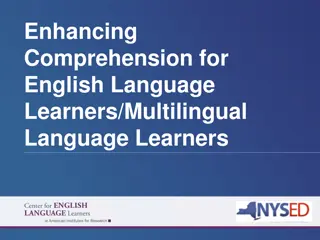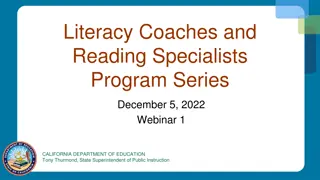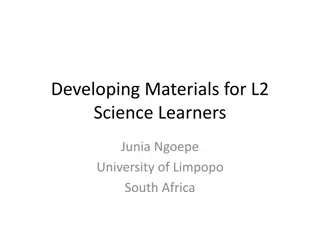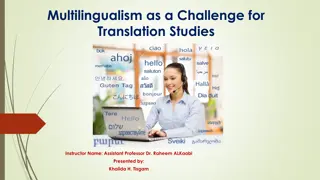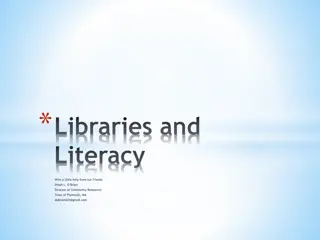The Science of Reading and Multilingualism: Supporting the Literacy and Language Development of English Learners.
Explore the importance of literacy and language development for English Learners (ELs) through the Science of Reading and Multilingualism. Learn about key objectives, terms, and foundations in supporting ELs in acquiring English and developing essential literacy skills.
Download Presentation

Please find below an Image/Link to download the presentation.
The content on the website is provided AS IS for your information and personal use only. It may not be sold, licensed, or shared on other websites without obtaining consent from the author.If you encounter any issues during the download, it is possible that the publisher has removed the file from their server.
You are allowed to download the files provided on this website for personal or commercial use, subject to the condition that they are used lawfully. All files are the property of their respective owners.
The content on the website is provided AS IS for your information and personal use only. It may not be sold, licensed, or shared on other websites without obtaining consent from the author.
E N D
Presentation Transcript
The Science of Reading and Multilingualism: Supporting the Literacy and Language Development of English Learners ELL Collaborative 2023 Summer Academy Administrator Day
A little bit about us Dr. Janna McClain Dr. Sungyoon Lee MTSU Assistant Professor of Elementary & Special Education Aerial Mosley, Ed.S Murfreesboro City Schools English Language Development Specialist MTSU Assistant Professor of Elementary & Special Education
Objectives 01 02 03 Implications for Programs Language & Literacy The Foundations ELD Services Tier 1 Supports Tier 2 or 3 Intervention Bilingual difference Phonics and Language ELD Matters! Who are ELs/MLs? Protected Rights Demographic Shifts
Terms EL/ELL (English Learner/ English Language Learner) ML/MLL (Multilingual Learner) Multilingual learners are students with a primary or home language other than English who are in the process of acquiring English.
Terms ESL (English as a Second Language) ELD (English Language Development) English language development is a service delivered by teachers who specialize in language-based instruction for multilingual learners.
Reading is the skill through which students access much of the educational content. Writing is how students demonstrate knowledge and express ideas essential acts of participation in an academic community. For these reasons, effective early literacy development is critical for all children. Too often, however, a one- size fits-all approach leaves some children behind. Too often, children who enter U.S. schools are not provided the instruction designed to address their needs, so they fail to develop essential literacy skills. This is decidedly true for a large number of English learner (EL) or emergent bilingual (EB) children in our nation s schools. -National Committee of Effective Literacy
01 The Foundations
Who Are ELs/MLs? Types of Multilinguals Sequential Bilingual Simultaneous Bilingual
Who Are ELs/MLs? Language Backgrounds Spanish (over 50%) Arabic (around 5%) Vietnamese, Kurdish, Somali, Karen, Lao, Mandarin, Gujarati, German, Japanese, Korean https://www.migrationpolicy.org/sites/default/files/publications/DLL-FactSheet-TN-FINAL.pdf
Who Are ELs/MLs? Language Background Race and Ethnicity Immigration Status Socioeconomic Status https://www.urban.org/features/part-us-data-driven-look-children-immigrants
Who Are ELs/MLs? 1 in 4 children in the U.S. have an immigrant parent 60% of those have at least one parent who is a U.S. Citizen 90% of those children are U.S. citizens https://www.urban.org/features/part-us-data-driven-look-children-immigrants
Who Are ELs/MLs? In immigrant families in the US 21% of parents have less than a high school diploma 92% of parents work 83% are two parent families 49% have low incomes https://www.urban.org/features/part-us-data-driven-look-children-immigrants
Protected Rights Key Court Cases and Policies
Key Court Cases: Lau vs. Nichols, 1974 "There is no equality of treatment by providing students with the same facilities, textbooks, teachers and curriculum, for students who do not understand English are effectively foreclosed from any meaningful education."
Key Court Cases: Lau vs. Nichols, 1974 "Basic English skills are at the very core of what public schools teach. Imposition of a requirement that, before a child can effectively participate in the educational program, he must already have acquired those basic skills is to make a mockery of public education."
Key Court Cases: Casta eda vs. Pickard, 1981 Districts must have Pedagogically sound plan Sufficient qualified staff Systems of evaluation
Key Court Cases: Plyler vs. Doe, 1982 Protects the rights of undocumented children to receive free public education
Protected Rights Receive English Language Development Supports Access grade level academic content Access any/all opportunities available to other students (including RTI supports) Access primary language support
Demographic/Infrastructure Shifts TN is a New Immigrant Destination (G ndara & Mordechay, 2017) TN had 45% growth in EL/ML population from 2011-2017 (https://www.tn.gov/content/dam/tn/education/cpm/EL_Framework.pdf)
State of Tennessee Data: WIDA Growth Met 2017-2020 No state-level data collected 43.8% 26% 2021-2022 2020-2021 TN EL students that met their growth trajectory on WIDA ACCESS TN EL students that met their growth trajectory on WIDA ACCESS
75% State Goal for Meeting WIDA Growth by 2025
Policy+Research+Practice= Policy+Research+Practice= ELD Program Implications ELD Program Implications Table Talk: How do these national and state demographics compare to your school or district?
02 The Relationship between Language & Literacy
Language processing in the bilingual mind differs from the monolingual mind. The development of literacy for a dual language brain is not the same as for a monolingual brain. The new language and literacy system is developed in the presence of and in interaction with an existing language system. -National Committee of Effective Literacy
The Bilingual Brain Languages don t function separately Multiple languages coexist in on holistic system in the brain Schools function from a monolingual lens BRAIN AND LANGUAGE 36, 3-15 (1989) Neurolinguists, Beware! The Bilingual Is Not Two Monolinguals in One Person. (Francois Grosjean)
What do you notice? What do you wonder? Letter written by 7 year old Korean- American Bilingual
Science of Reading Converging research evidence of what works in literacy instruction Practices proven by extensive research to effectively teach children how to read Key Framework: The Simple View of Reading
The Simple View of Reading is a theory that attempts to define the skills that contribute to early reading comprehension (Gough & Tunmer, 1986). Language Comprehension Decoding Reading Comprehension X = = Simple View of Reading
The Simple View of Reading is a theory that attempts to define the skills that contribute to early reading comprehension (Gough & Tunmer, 1986). Language Comprehension Decoding Reading Comprehension X = Cognitive model (i.e., excludes many other factors) High explanatory power (almost 90% of variance) Simple View of Reading
The Simple View of Reading is a theory that attempts to define the skills that contribute to early reading comprehension (Gough & Tunmer, 1986). Language Comprehension Decoding Reading Comprehension X = Simple View of Reading
Decoding X Language Comprehension = Reading Comprehension What does this say ? / z s k n r f ?/ Decoding the sounds = 0% Language Comprehension = 100% Reading Comprehension = ? Simple View of Reading
Decoding X Language Comprehension = Reading Comprehension What does this say ? Kuusi Palaa Simple View of Reading
Decoding X Language Comprehension = Reading Comprehension What does this say ? Kuusi Palaa Decoding the sounds = 100% Language Comprehension = 0% Reading Comprehension = ? Simple View of Reading
Word recognition is but not Sufficient for reading comprehension.
TN Sounds First Heavy focus on sounds (i.e., letter-sound correspondence) Automatic word recognition skills
Policy+Research+Practice= Policy+Research+Practice= ELD Program Implications ELD Program Implications Table Talk: Why do we see heavy emphasis on one piece of the equation?
Decoding is a constrained skill Decoding is a constrained skill When comparing word recognition and language comprehension, word recognition is Easier to measure Easier to master/show growth Easier to teach systematically Easier to establish significant effect sizes -Paris, 2014
Constrained Skill Theory (Paris, 2005) Constrained Skill Theory (Paris, 2005) Constrained Unconstrained A small number of elements Ex. knowing the alphabet Specific influences Precise assessments Conceptually unbound Ex. Vocabulary knowledge Related to cognitive skills Less precise assessments Highly constrained Unconstrained Oral Reading Fluency Vocabulary & Comprehension Writing Name High Frequency Words Phonological Awareness Phonics
Language comprehension is an important component of reading that develops alongside decoding and becomes ever more important in the reading process as students move through the elementary grades. Thus, in conversations about the science of reading, language comprehension, and how to support its development among diverse populations, should not be overlooked. -Silverman et al., 2020
National Reading Panel Findings National Reading Panel Findings 2000 National Reading Panel Systematic and explicit instruction in component reading skills. Studied monolingual English speakers
National Reading Panel Findings National Reading Panel Findings 2000 National Reading Panel Often misunderstood that the report put a greater emphasis on phonemic awareness and phonics instruction (Shanahan, 2003). Studied monolingual English speakers
National Literacy Panel National Literacy Panel Findings Findings 2006 Language-minority students and monolinguals have equivalent word-level skills (e.g., decoding, spelling). Report of the National Literacy Panel for Language Minority Children and Youth Studied English Language Learners But this is not the case for text level skills (e.g., reading comprehension, writing).
National Literacy Panel National Literacy Panel Findings Findings 2006 Students benefit significantly from the integration of language development with content, with an emphasis on meaning. Report of the National Literacy Panel for Language Minority Children and Youth Studied English Language Learners
Thanks! Do you have any questions? janna.mcclain@mtsu.edu sungyoon.lee@mtsu.edu aerial.mosley@cityschools.net CREDITS: This presentation template was created by Slidesgo, and includes icons by Flaticon, and infographics & images by Freepik Please keep this slide for attribution
03 Programmatic Considerations
For MLs/ELs, the sound-symbol mapping system does not connect to already present familiarity with speech sounds and known words of the language in which they are learning to read. ELs have a great deal of linguistic (and general) knowledge in their L1, which can be used to bootstrap learning in English. Nonetheless, learning to read, which includes learning the idea of reading, is harder in a L2. -Goldenberg, 2020
Meeting the Language and Literacy Needs of ELs/MLs Tier 1 English Language Arts English Language Development Reading Intervention if needed
Tier 1 English Language Arts Instruction




